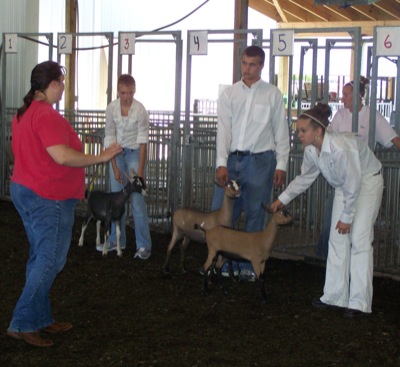Saturday, August 9th, 2008
Naaaa, goats are not all the same
By William Kincaid

Photo by William Kincaid/The Daily Standard
Lorinda Reeves of Belle Center evaluates competitors during the 2008 Mercer County Fair's goat show on Friday afternoon at the Coldwater Young Farmers Arena. According to officials, the number of competing goats was up dramatically this year.
To some city folk, goats may be stereotyped as sheep-like animals with a propensity to eat anything.
But to Rodney and Lorinda Reeves of Belle Center, there are a myriad of temperamental and physical differences to assess before choosing the best goats in various categories.
And there were plenty of the domesticated creatures for the Reeves - selected as this year's judges - to evaluate during the 2008 goat show at the Mercer County Fair on Friday afternoon.
According to onsite fair officials, 93 goats were registered for the junior fair show on Friday at the Coldwater Young Farmers Arena, up at least 25 from last year.
Contestants from county 4-H Clubs, FFAs and scout groups were judged in multiple categories: showmanship, dairy goat show, Boer goat show and specialty show, consisting of pygmy, dwarf and market goats.
The usually shorter Boer goats - valued for their muscle meat - range from 180 to 200 pounds while the dairy goats average around 100 to 150 pounds, Rodney Reeves said.
"It's like a football player walking in with basketball players," Reeves, speaking in absolute laymen's terms, said about the Boers, which are shorter, heavier and more compact than the dairy goats.
Years of breeding from the progenitor South African goat were need to produce the larger Boer, he said.
For the Friday show at the fair, all breeds of goat were mixed together.
Dairy goats, according to Reeves, usually produce up to a gallon of milk for more than 170 consecutive days. Therefore it's imperative the goat has ample body capacity to support its milk production, Reeves said.
The couple - who sometimes switch judging duties during shows - rate the dairy goats by, among other characteristics, how straight it walks, which Reeves said reveals how well its body supports itself.
The huskier Boers, on the other hand, are judged by how much muscle they have, as well as their potential to produce muscle in their offspring. Any Boer carcass yielding 55 percent muscle is considered satisfactory, he said.
"Obviously the higher percent you can get is better for the consumer," he said.
But during the showmanship contest, the children competitors are scrutinized as much as the goat, Reeves said.
Each contestant must present their goat with poise and politeness to the others. An impressive goat will stand still, impervious to the nearby distraction of other goats, people and noises.
"It's difficult to do with any animal," Reeves said, adding the goat's comfort level is paramount.
During one of the afternoon's judging, one goat bumped another goats tail.
"There are so many things that go into it," Reeves said about training.
Like humans, goats have different temperaments, attitudes and personalities, he said. And as much as a goat is trained, on show day, it's a new arena.
"It's a totally different barn than their barn at home," he said.
Anything from dissimilar tasting drinking water, to people, rival goats and the show announcers can perturb the animal.
"I guarantee you nobody has a PA in their barn," he said.
Reeves suggest turning on radio - preferably to a radio-talk station - during training to prepare the goats for alien noises on show day.
Coldwater High School vocational agriculture teacher Dennis Riethman, who was present to watch some of his students compete, including Jenny Huser, who won best professional showmanship, said much work is involved in training.
"There's a lot of behind the scenes hours that go into getting them ready," Riethman said.
In addition to feeding, much depends on selection breeding and genetics, he said.
Reeves praised the fairground's goat arena that, unlike some venues, has a separate entrance and exit, which expedites the show.
"This is a pretty nice setup," he said
The Reeves and their now 3-month-old baby gained their insights through raising goats for eight years.
"We've judged about four years now. This is our first time to Celina," he said.
The couple has a total of seven children, many who are involved in training goats as well.
